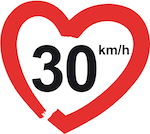Legislation allowing for 30-km /h zones since 1989 (40-km/h zones before, plus legislation about signalling also allowing for lower speed limits for safety reasons, since 1975). Many cities introduced 30 km/h zones from 1989 on. Ca 38% of Suisse citizens are living in 30 km/h zones today. The “Ville à 30” network has members in Switzerland.
| Basel | 174.400 residents | many 30 km/h zones, expansion to main roads since 2013 |
| Bern | 128.800 residents | 30 km/h in nearly all residential quarters. Expansion to main roads since 2013. “Berner Modell”: a standardised procedure to implement traffic calming on roads, goal: “coexistence, no predominance in road traffic”; additional projects for traffic calming in the county, like in Köniz or Zollikofen |
| Disentis / Muster | 2.3000 residents | Wide 30 km/h areas, including two through roads; got Ł merit award by „Fussverkehr Schweiz“ in 2011. |
| Genf | 191.600 residents | Member of “Ville à 30”, with several 20km/h and 30 km/h zones. 30 km/h zones are to be extended to the whole city (except main roads and a few areas) |
| Köniz | 39.800 residents | first 30km/h introduction in 1996; 30 km/h in the city centre, including a main with heavy traffic in the city centre. Pilot project with different traffic calming measures since 2006 found great acceptance and widespread positive response. |
| Lausanne | 132.600 residents | 30 km/h in nearly all residential quarters |
| Luzern | 80.500 residents | 30 km/h was implemented without major physical changes on the road infrastructure. First zone in the mid-nineties, most residential roads with 30 km/h, today; additional measures planned in order to close gaps in the network. |
| Münsingen | 11.500 residents | 30km/h implemented in two residential areas, “Ortsteil West” and “Bärenstutz/Sonnhalde” , third area is just being implemented; plannings are to implement 30 km/h in all residential areas |
| Neuchatel/ Neuenburg |
33.600 residents | 30 km/h on all urban minor roads: Roundabouts and traffic-calmed streets with children allowed to play were set up in order to ensure compliance. |
| Olten | 17.300 residents | 30 km/h in all residential quarters, plus shared-space area |
| Renens b. Lausanne | 20.100 residents | 30 km/h in the whole municipality, implemented simultaneously, at the end of 2010. Exceptions on arterial roads; comprehensive campaigns for awareness raising, several physical changes to the roads. |
| Sion | 33.000 residents | first three 30km/h zones were implemented in the 90ies; major parts of the city with 30 km/h, has also implemented a pedestrian zone |
| St. Gallen | 74.600 residents | 30 km/h in about 20 residential areas, which equals two thirds of all residential areas; more limits implemented when deemed necessary; one implementation project was stopped by a referendum, another because of a court sentence. |
| Winterthur | 105.700 residents | 30 km/h in most residential quarters, local authorities encouraging citizens to apply for more zones |
| Zollikon | 12.300 residents | member of “Ville à 30”, approval up to 90% of the inhabitants. Municipality managed to make the streets “ready for 30 km/h” within a few months, was awarded by the Swiss Council for Accident Prevention for their campaign (2004) |
| Zürich | 404.800 residents | successive measures for noise reduction, for 28 years; first 30 km/h zone in 1989, followed by many more zones; pilote project “Kalchbühlstraße – noise remediation through 30 km/h?”. Extension of 30 km/h to main roads since 2013 |
